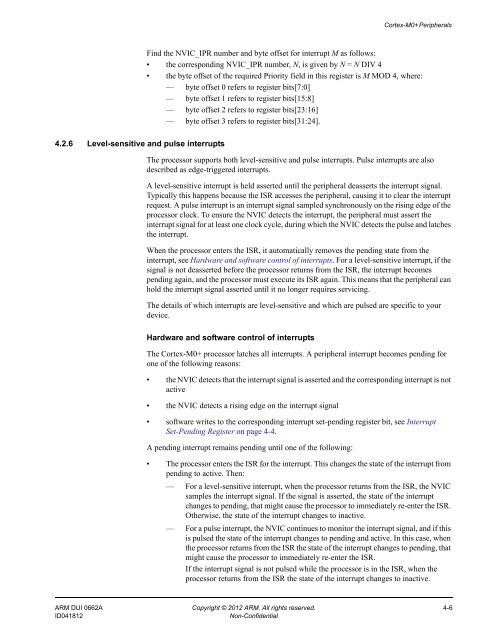Cortex-M0+ Devices Generic User Guide - Keil
Cortex-M0+ Devices Generic User Guide - Keil
Cortex-M0+ Devices Generic User Guide - Keil
You also want an ePaper? Increase the reach of your titles
YUMPU automatically turns print PDFs into web optimized ePapers that Google loves.
<strong>Cortex</strong>-<strong>M0+</strong> PeripheralsFind the NVIC_IPR number and byte offset for interrupt M as follows:• the corresponding NVIC_IPR number, N, is given by N = N DIV 4• the byte offset of the required Priority field in this register is M MOD 4, where:— byte offset 0 refers to register bits[7:0]— byte offset 1 refers to register bits[15:8]— byte offset 2 refers to register bits[23:16]— byte offset 3 refers to register bits[31:24].4.2.6 Level-sensitive and pulse interruptsThe processor supports both level-sensitive and pulse interrupts. Pulse interrupts are alsodescribed as edge-triggered interrupts.A level-sensitive interrupt is held asserted until the peripheral deasserts the interrupt signal.Typically this happens because the ISR accesses the peripheral, causing it to clear the interruptrequest. A pulse interrupt is an interrupt signal sampled synchronously on the rising edge of theprocessor clock. To ensure the NVIC detects the interrupt, the peripheral must assert theinterrupt signal for at least one clock cycle, during which the NVIC detects the pulse and latchesthe interrupt.When the processor enters the ISR, it automatically removes the pending state from theinterrupt, see Hardware and software control of interrupts. For a level-sensitive interrupt, if thesignal is not deasserted before the processor returns from the ISR, the interrupt becomespending again, and the processor must execute its ISR again. This means that the peripheral canhold the interrupt signal asserted until it no longer requires servicing.The details of which interrupts are level-sensitive and which are pulsed are specific to yourdevice.Hardware and software control of interruptsThe <strong>Cortex</strong>-<strong>M0+</strong> processor latches all interrupts. A peripheral interrupt becomes pending forone of the following reasons:• the NVIC detects that the interrupt signal is asserted and the corresponding interrupt is notactive• the NVIC detects a rising edge on the interrupt signal• software writes to the corresponding interrupt set-pending register bit, see InterruptSet-Pending Register on page 4-4.A pending interrupt remains pending until one of the following:• The processor enters the ISR for the interrupt. This changes the state of the interrupt frompending to active. Then:— For a level-sensitive interrupt, when the processor returns from the ISR, the NVICsamples the interrupt signal. If the signal is asserted, the state of the interruptchanges to pending, that might cause the processor to immediately re-enter the ISR.Otherwise, the state of the interrupt changes to inactive.— For a pulse interrupt, the NVIC continues to monitor the interrupt signal, and if thisis pulsed the state of the interrupt changes to pending and active. In this case, whenthe processor returns from the ISR the state of the interrupt changes to pending, thatmight cause the processor to immediately re-enter the ISR.If the interrupt signal is not pulsed while the processor is in the ISR, when theprocessor returns from the ISR the state of the interrupt changes to inactive.ARM DUI 0662A Copyright © 2012 ARM. All rights reserved. 4-6ID041812Non-Confidential
















